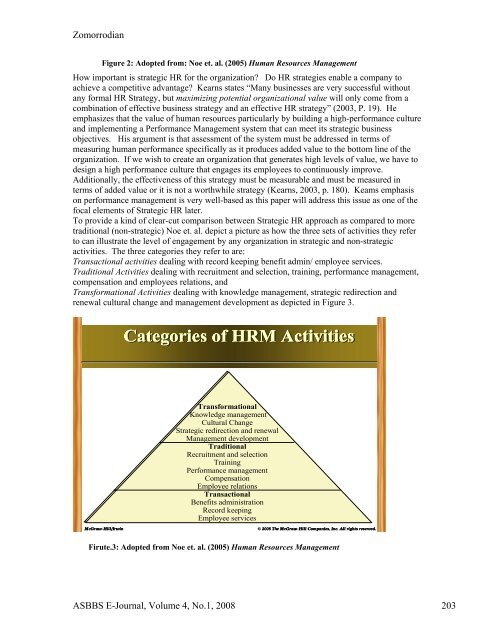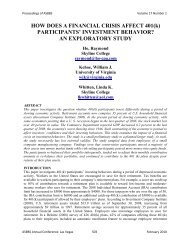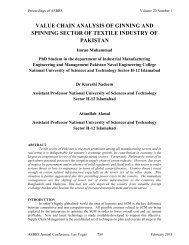stock repurchase announcements: a test of market ... - Asbbs.org
stock repurchase announcements: a test of market ... - Asbbs.org
stock repurchase announcements: a test of market ... - Asbbs.org
Create successful ePaper yourself
Turn your PDF publications into a flip-book with our unique Google optimized e-Paper software.
Zomorrodian<br />
Figure 2: Adopted from: Noe et. al. (2005) Human Resources Management<br />
How important is strategic HR for the <strong>org</strong>anization? Do HR strategies enable a company to<br />
achieve a competitive advantage? Kearns states “Many businesses are very successful without<br />
any formal HR Strategy, but maximizing potential <strong>org</strong>anizational value will only come from a<br />
combination <strong>of</strong> effective business strategy and an effective HR strategy” (2003, P. 19). He<br />
emphasizes that the value <strong>of</strong> human resources particularly by building a high-performance culture<br />
and implementing a Performance Management system that can meet its strategic business<br />
objectives. His argument is that assessment <strong>of</strong> the system must be addressed in terms <strong>of</strong><br />
measuring human performance specifically as it produces added value to the bottom line <strong>of</strong> the<br />
<strong>org</strong>anization. If we wish to create an <strong>org</strong>anization that generates high levels <strong>of</strong> value, we have to<br />
design a high performance culture that engages its employees to continuously improve.<br />
Additionally, the effectiveness <strong>of</strong> this strategy must be measurable and must be measured in<br />
terms <strong>of</strong> added value or it is not a worthwhile strategy (Kearns, 2003, p. 180). Keams emphasis<br />
on performance management is very well-based as this paper will address this issue as one <strong>of</strong> the<br />
focal elements <strong>of</strong> Strategic HR later.<br />
To provide a kind <strong>of</strong> clear-cut comparison between Strategic HR approach as compared to more<br />
traditional (non-strategic) Noe et. al. depict a picture as how the three sets <strong>of</strong> activities they refer<br />
to can illustrate the level <strong>of</strong> engagement by any <strong>org</strong>anization in strategic and non-strategic<br />
activities. The three categories they refer to are:<br />
Transactional activities dealing with record keeping benefit admin/ employee services.<br />
Traditional Activities dealing with recruitment and selection, training, performance management,<br />
compensation and employees relations, and<br />
Transformational Activities dealing with knowledge management, strategic redirection and<br />
renewal cultural change and management development as depicted in Figure 3.<br />
Categories Categories <strong>of</strong> <strong>of</strong> HRM HRM Activities<br />
Activities<br />
Transformational<br />
Knowledge management<br />
Cultural Change<br />
Strategic redirection and renewal<br />
Management development<br />
Traditional<br />
Recruitment and selection<br />
Training<br />
Performance management<br />
Compensation<br />
Employee relations<br />
Transactional<br />
Benefits administration<br />
Record keeping<br />
Employee services<br />
McGraw-Hill/Irwin © 2006 The McGraw-Hill Companies, Inc. All rights reserved.<br />
Firute.3: Adopted from Noe et. al. (2005) Human Resources Management<br />
ASBBS E-Journal, Volume 4, No.1, 2008 203

















